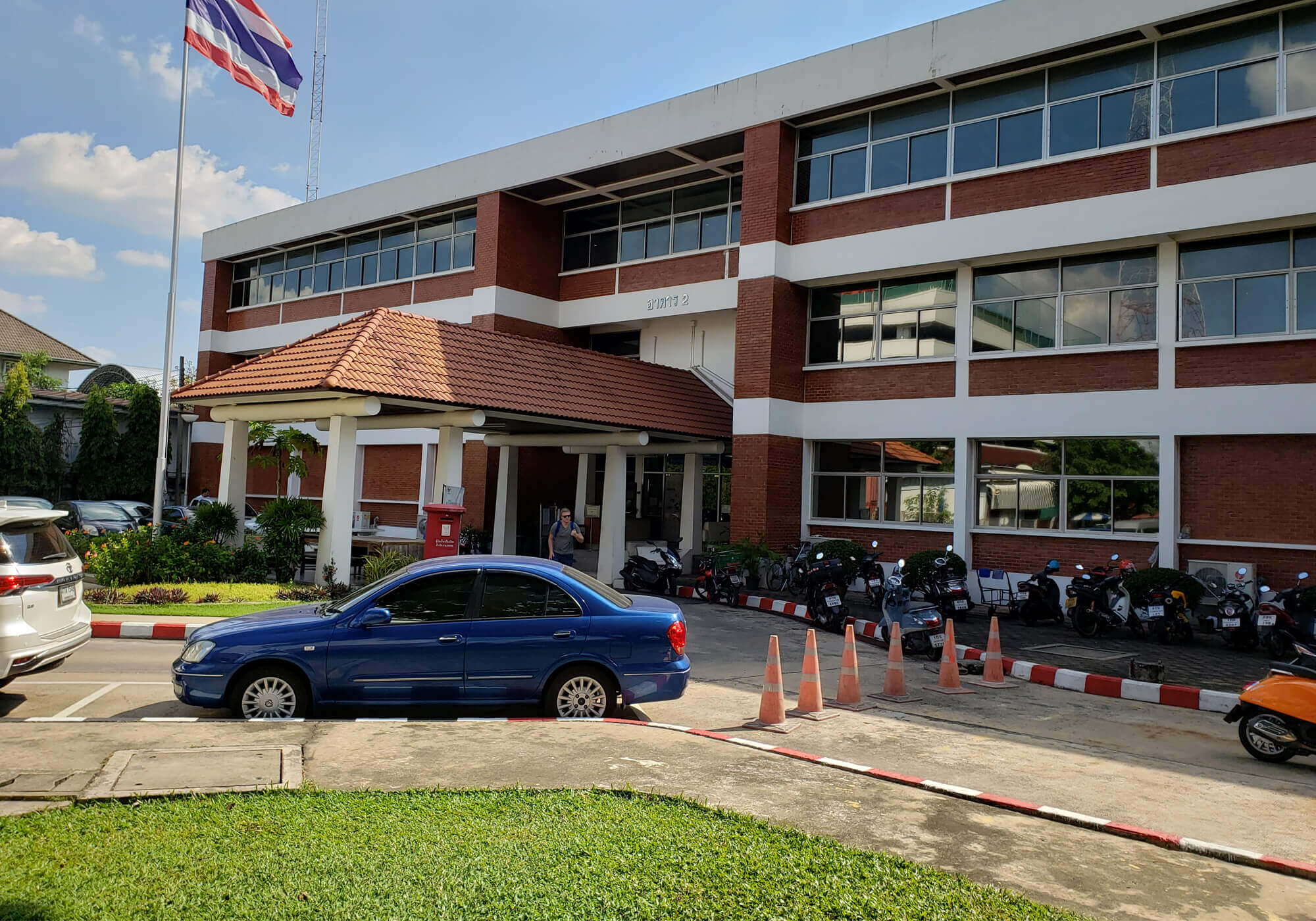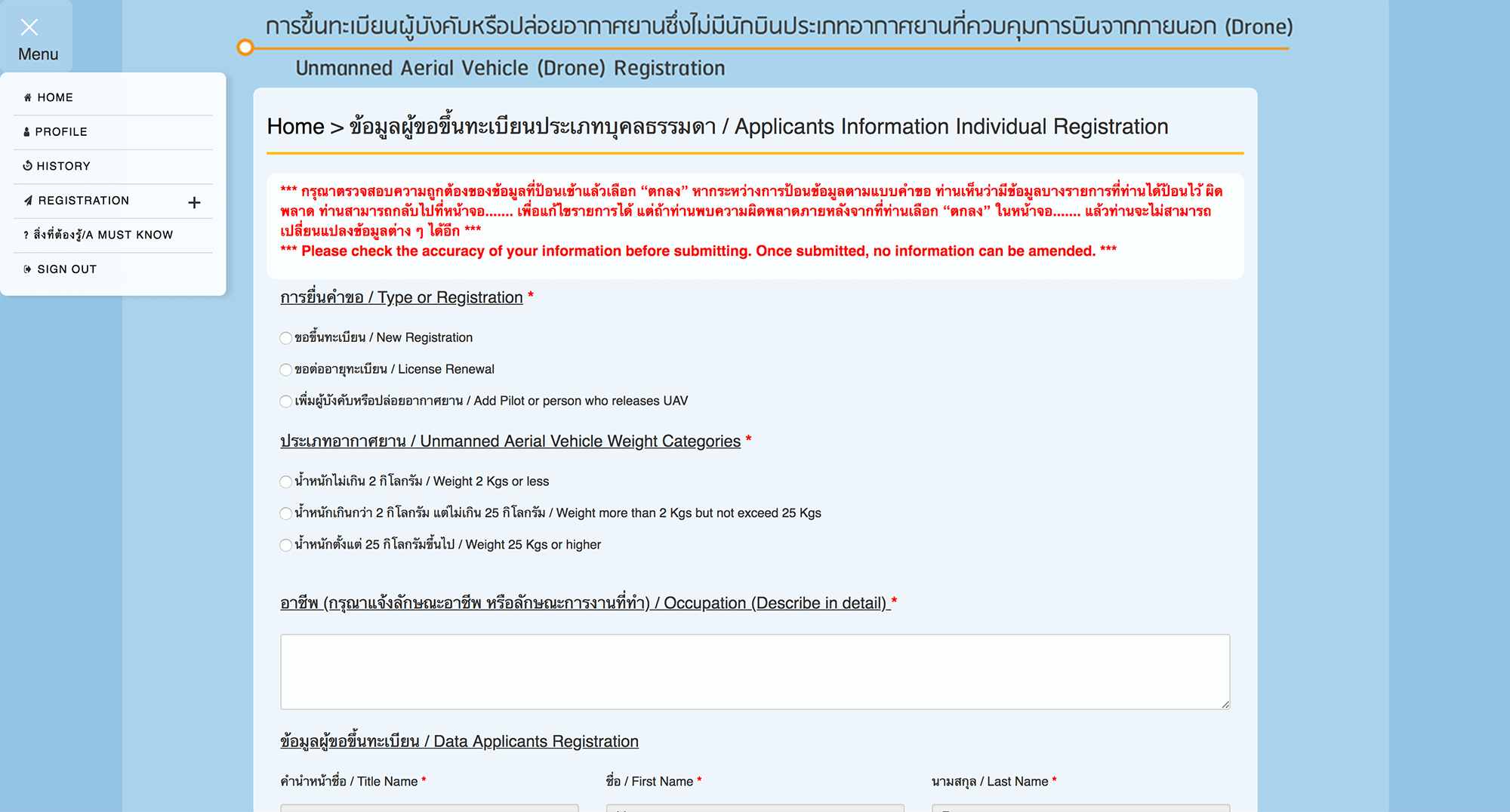How to register a drone in Thailand

A step-by-step guide to registering your drone (for free) in Thailand for personal/hobbyist use.
Last updated: 5th February 2020
It is absolutely fine to enter Thailand with a drone. However in order to fly your drone, you must be registered with paperwork from two different corporations: CAAT (Civil Aviation Authority of Thailand) and NBTC (National Broadcasting and Telecommunications Commission). We assume your drone is for non-commercial use, is under 2kg and has a camera.
Fines for not complying range from 40,000 baht to 100,000 baht and 1-5 years in prison.
For rules and advice flying your drone in Thailand, see our advice for flying your drone in Thailand.
You will need patience as although this registration system, it’s annoyingly complex, time consuming and rarely makes sense. Leave comments below if you’re in need of help.
Sign up for our travel updates, we’ll notify you if the process for registering your drone changes (for good or for worse) or if there’s anything that might affect the way you fly in Thailand
Update (1st Oct 2019): If you are planning to register with CAAT before entering Thailand you must have already obtained a visa. After some of you had a problem and commented, I called CAAT and NBTC to confirm what should be done and they told me it is not possible to register online if you don’t have a visa (entering with 30 day visa exemption). They wouldn’t/couldn’t give any further advice.
1. Purchase third-party liability insurance
You need third-party liability insurance with a minimum coverage of 1 million baht.
There are many options available both within Thailand and internationally. It will depend on your personal preference and the level of cover you want. It is important that your insurance paperwork is in English and states your name and drone serial number.
The point about the drone model and serial number on the paperwork is important, they will reject the application without it.
2. Register with NBTC (in person)
Documents for NBTC (printed copies):
- Photograph clearly showing drone serial number
- Photograph clearly showing remote/transmitter serial number
- Photocopy of passport, entry stamp, & departure card
- Receipt of hotel, condo, house book etc showing where you are living or staying.
- Photocopy of drone purchase receipt (not needed if registering as a tourist)
- Completed คท30 form – Download here
- Completed คท32 form – Download here
NBTC currently have 17 offices in Thailand.
Their locations are divided in to 4 sections on their website (PorPor 1-4), but to summarise:
- Bangkok
- Nonthaburi
- Chanthaburi
- Suphanburi
- Prachin Buri
- Ubon Ratchathani
- Khon Kaen
- Nakhon Rachasima
- Udon Thani
- Lampang
- Chiang Mai
- Phitsanulok
- Chiang Rai
- Hat Yai
- Phuket
- Nakhon Si Thammarat
- Ranong
- Chumphon
We used the office in Bangkok (Soi Phahonyothin 8), found here.
Telephone: 02 271 7600
Website: http://nbtc.go.th
Opening hours: Mon-Fri 8:30am-4:30PM
You do not need an appointment at the NBTC office. If you’re visiting the office in Bangkok, you can walk from Ari BTS station. Turn up with a pen and your paperwork. They’ll check the document and issue your certificate in 15 minutes.
Arriving at NBTC in Bangkok you’ll see this building:

Enter the gates and turn immediately right. The building to register your drone is this one:

Extra notes:
- Fill out the form with your address in Thailand.
- You don’t need to take your drone to the office.
- Tourists will only receive a document valid until the exit date stamped in to their passport.
- Something interesting to note is that the officer would not grant us more than a temporary document. At first he said it is because he frequency on drones purchased outside of Thailand is different to those purchased within the country and it would affect surrounding WiFi signals. Then he said the power output is not the same as drones within Thailand. Finally the reason was settled – Drones purchased outside of Thailand have not had tax paid and so the only thing I can do is get a temporary document. Just be aware of that, and if you purchased your drone in Thailand, take a receipt. We did not have a receipt, but could still register as a ‘tourist’.
Edit: On our second visit to NBTC the officer told us the only problem is that our drone was bought outside of Thailand. To get anything other than a temporary certificate, we must import the drone and pay whatever taxes are due. Bottom line is, you’re better off buying your drone in Thailand even if it’s a little more expensive.
Addition (6th January 2020): Unfortunately Every time I visit the NBTC office I am told something different. Even if you purchased the drone in Thailand AND you hold a work permit, permanent residency, or a Thailand Elite Visa – as a foreigner, you cannot register your drone for more than three months. Thai citizens can of course. This is just another additional frustrating problem in a flawed system.
Update: A few of you messaged us to let us know it was not possible to register ahead of time as they require a copy of your latest visa and/or entry stamp. It’s something you may be able to get around if you have already visited Thailand. This was useful information so thank you for your comments.
3. Register with CAAT (online)
Some websites are reporting that CAAT registration is not needed if the drone is less than 2KG – This is only true if the drone does not have a camera
Registering with CAAT takes the most time. Their website states 15 days but from our experience you may be waiting many months – we waited almost 6 months whilst a friend only waited a few days – who knows.
Recently, other travelers and expats have been reporting much faster turn around times of 10-14 days
We registered with CAAT first, however the officer at the NBTC office and other documents in Thai said that we should register with NBTC before CAAT. If you’re traveling for a short period of time this will not work as you need to register in person for NBTC.

Documents for CAAT (digital):
- Proof of address
- Your passport photo page/li>
- Pictures of your drone including serial numbers of the drone and the transmitter/remote
- Liability insurance documents
- Signed self declaration form (downloaded during registration process)
The CAAT website states that the application form only works in Google Chrome.
This is the link for their free online registration: uasportal.caat.or.th.
The website has some bugs and usability issues with a few broken features. We couldn’t make the save progress button work, sometimes the uploads would not work, and we were able to see other people’s applications alongside our own.
To start the process, access the menu and start an “Individual” application. Scroll down and look for the “Drone register” button where you’ll be guided through creating a new account. Read and accept the 3 tabs/pages of conditions and press continue. If you’re prompted with “กรุณากดยอมรับเงื่อนไขก่อนทำการบินก่อนค่ะ”, you forgot to click “accept” on one of the pages.
Continue the registration process but do not send the application until it is complete, it is not currently possible to change your form after submission.
After we submitted the application, the page stopped responding and we had to reload the website, visit our account and submit the documents separately from the main form. If this happens, don’t forget to go back to upload your supporting documents.
4. Know the drone rules and laws in Thailand
There have been many public cases of prosecution which ended in large fines being paid so familiarize yourself with the rules and laws for flying drones in Thailand. You can read our advice here.
We recommend carrying a copy of your insurance, registration documents and rules from the CAAT and NBTC website with you when you are traveling with your drone. Don’t expect every guard, police officer or other person to know the rules.
Tip: If you’re feeling discouraged by this process and wondering if it’s worth it, check out our videos to get an idea of the amazing landscapes you’ll be able to fly over here. Our Koh Lipe drone video is particularly inspiring 😉
